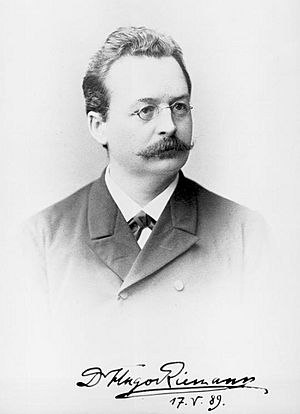Hugo Riemann facts for kids
Quick facts for kids
(Karl Wilhelm Julius) Hugo Riemann
|
|
|---|---|

Hugo Riemann (Hamburg, 1889)
|
|
| Born |
Karl Wilhelm Julius Hugo Riemann
18 July 1849 Grossmehlra (Sondershausen), German Confederation
|
| Died | 10 July 1919 (aged 69) |
| Nationality | German |
Karl Wilhelm Julius Hugo Riemann (born July 18, 1849 – died July 10, 1919) was a German musicologist and composer. He was one of the people who helped start modern musicology. Hugo Riemann was a top music expert in Europe during his time. He was very important as both a music theorist (someone who studies how music works) and a music historian (someone who studies music's past). Many of his ideas are now known as Riemannian theory.
About Hugo Riemann
Hugo Riemann was born in a place called Grossmehlra, in what was then Schwarzburg-Sondershausen.
His first music lessons came from his father, Robert Riemann. His father was a landowner who loved music and wrote songs. Hugo learned Music theory from Heinrich Frankenberger. He also learned to play the piano from August Barthel and Theodor Ratzenberger. Theodor Ratzenberger had even studied with the famous composer Franz Liszt. Hugo finished his schooling in Sondershausen and Arnstadt.
Riemann first studied law, then philosophy and history. He went to universities in Berlin and Tübingen. After fighting in the Franco-Prussian War, he decided to focus his life on music. He then studied at the Leipzig Conservatory. For a few years, he worked as a teacher and conductor in Bielefeld. In 1878, he returned to Leipzig University as a visiting professor.
He hoped to get a job at the Conservatory but it didn't happen. So, Riemann moved to Bromberg in 1880. From 1881 to 1890, he taught piano and music theory at the Hamburg Conservatory. After a short time at the Sondershausen Conservatory, he taught at the Wiesbaden Conservatory from 1890 to 1895. Finally, he returned to Leipzig University in 1895 as a lecturer. In 1901, he became a full professor. By 1914, he was made the Director of the Institute of Musicology.
Hugo Riemann passed away from jaundice just eight days before his 70th birthday.
His Music Ideas
Riemann was one of the most important music theorists. In his books and lectures, he created many terms that musicians still use today. For example, he developed the idea of harmonic function theory. This includes popular terms like tonic, dominant, subdominant, and parallel. He also came up with the idea of the musical phrase, which is a basic part of music education today.
Some of his most famous books include:
- The Musik-Lexikon (1882): This was a complete dictionary of music and musicians.
- The Geschichte der musiktheorie im IX.-XIX. jahrhundert (1898): This book covered the history of music theory in Europe up to the 19th century.
- The Handbuch der Harmonielehre: This was a book about studying harmony (how chords work together).
- The Lehrbuch des Contrapunkts: This book was about counterpoint (how different musical lines fit together).
All these books were translated into English.
His Geschichte book was used by music teachers for about 50 years. In this book, he carefully wrote about how polyphonic music theory developed. Polyphonic music has many independent melodies playing at once. He believed that common musical intervals (the distance between two notes) were used naturally in folk music. As he grew as a theorist, his ideas became more practical. He started using ideas from psychology to explain music.
Riemann supported a theory called harmonic dualism. His theory of harmonic function is still the basis for how harmony is taught in Germany. He also created a set of harmonic transformations. These ideas were later used by an American theorist named David Lewin. This led to a major part of neo-Riemannian theory. Another important part of modern neo-Riemannian theory, the Tonnetz, was not Riemann's invention. However, he helped make it well-known.
He wrote many works on different parts of music. Some of his students included the German composer Max Reger and the musicologist Walter Niemann.
His Compositions
Hugo Riemann also wrote many musical pieces. These included pieces for piano, songs, a piano sonata, six sonatinas, a violin sonata, and a string quartet.
See also
 In Spanish: Hugo Riemann para niños
In Spanish: Hugo Riemann para niños
- Riemannian theory
- Neo-Riemannian theory
- Chordal space
- Modulatory space
- Functional harmony
- Parallel and counter parallel

